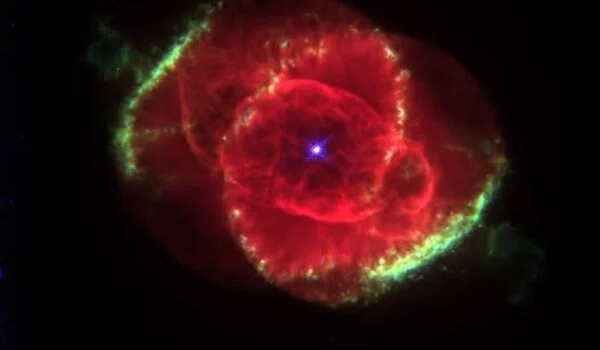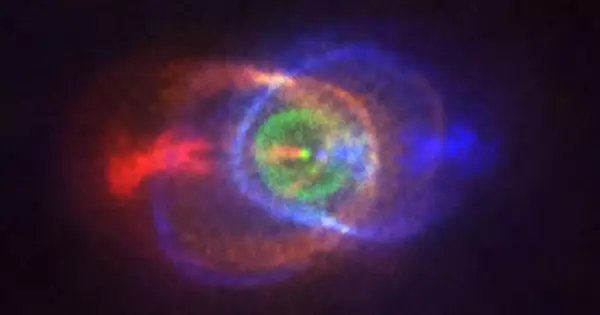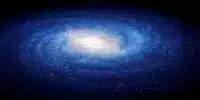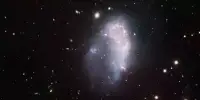For the first time, scientists using the Atacama Large Millimeter/submillimeter Array (ALMA), an international observatory co-operated by the US National Science Foundation’s National Radio Astronomy Observatory (NRAO), recorded millimeter-wavelength light from a fiery explosion caused by the merger of a neutron star and another star. The team also confirmed that this flash of light was one of the most energetic short-duration gamma-ray bursts ever observed, leaving behind one of the brightest afterglows ever recorded. The findings of the study will be published in a future issue of The Astrophysical Journal Letters.
GRBs are the brightest and most energetic explosions in the Universe, capable of emitted more energy in a matter of seconds than our Sun will emit in its entire lifetime. GRB 211106A is a short-duration gamma-ray burst, which is a subclass of GRBs. The catastrophic merger of binary star systems containing a neutron star results in these explosions, which scientists believe are responsible for the creation of the heaviest elements in the Universe, such as platinum and gold.
“These mergers occur because of gravitational wave radiation that removes energy from the orbit of the binary stars, causing the stars to spiral in toward each other,” said Tanmoy Laskar, who will soon commence work as an Assistant Professor of Physics and Astronomy at the University of Utah. “The resulting explosion is accompanied by jets moving at close to the speed of light. When one of these jets is pointed at Earth, we observe a short pulse of gamma-ray radiation or a short-duration GRB.”
Afterglow light is essential for figuring out which galaxy a burst comes from and for learning more about the burst itself. Initially, when only the X-ray counterpart had been discovered, astronomers thought that this burst might be coming from a nearby galaxy.
Tanmoy Laskar
A GRB with a short duration usually lasts only a few tenths of a second. Scientists then look for an afterglow, a light emission caused by the jets’ interaction with the surrounding gas. Even so, they’re difficult to detect; only about a half-dozen short-duration GRBs have been detected at radio wavelengths, and none have been detected at millimeter wavelengths until now. The difficulty, according to Laskar, who led the research while an Excellence Fellow at Radboud University in the Netherlands, is the enormous distance to GRBs and the technological capabilities of telescopes.
“Short-duration GRB afterglows are very luminous and energetic. But these explosions take place in distant galaxies which means the light from them can be quite faint for our telescopes on Earth. Before ALMA, millimeter telescopes were not sensitive enough to detect these afterglows.”

GRB 211106A is no exception, having occurred when the Universe was only 40% of its current age. The light from this short-duration gamma-ray burst was so faint that while early X-ray observations with NASA’s Neil Gehrels Swift Observatory detected the explosion, the host galaxy was undetectable at that wavelength, and scientists were unable to determine where the explosion was coming from.
“Afterglow light is essential for figuring out which galaxy a burst comes from and for learning more about the burst itself. Initially, when only the X-ray counterpart had been discovered, astronomers thought that this burst might be coming from a nearby galaxy,” said Laskar, adding that a significant amount of dust in the area also obscured the object from detection in optical observations with the Hubble Space Telescope.
Each wavelength added a new dimension to scientists’ understanding of the GRB, and millimeter wavelength in particular was critical to uncovering the truth about the burst. “The Hubble observations revealed an unchanging field of galaxies; ALMA’s unparalleled sensitivity allowed us to pinpoint the location of the GRB in that field with greater precision, and it turned out to be in another faint galaxy, which is further away; this means that this short-duration gamma-ray burst is even more powerful than we first thought, making it one of the most luminous and energetic on record,” said Laskar.
Wen-fai Fong, an Assistant Professor of Physics and Astronomy at Northwestern University added, “This short gamma-ray burst was the first time we tried to observe such an event with ALMA. Afterglows for short bursts are very difficult to come by, so it was spectacular to catch this event shining so bright. After many years of observing these bursts, this surprising discovery opens up a new area of study, as it motivates us to observe many more of these with ALMA, and other telescope arrays, in the future.”
According to Joe Pesce, National Science Foundation Program Officer for NRAO/ALMA, “On many levels, these observations are fantastic. They add to our understanding of the mysterious gamma-ray bursts (and neutron-star astrophysics in general), and they demonstrate the importance of multi-wavelength observations with space- and ground-based telescopes in understanding astrophysical phenomena.”
And there’s still a lot of work to be done across multiple wavelengths, both with new GRBs and with GRB 211106A, to uncover more surprises about these bursts. “The study of short-duration GRBs necessitates the rapid coordination of telescopes operating at all wavelengths around the world and in space,” said Edo Berger, Professor of Astronomy at Harvard University and researcher at the Center for Astrophysics | Harvard & Smithsonian.
“In the case of GRB 211106A, we used some of the most powerful telescopes available — ALMA, the National Science Foundation’s Karl G. Jansky Very Large Array (VLA), NASA’s Chandra X-ray Observatory, and the Hubble Space Telescope. With the now-operational James Webb Space Telescope (JWST), and future 20-40 meter optical and radio telescopes such as the next generation VLA (ngVLA) we will be able to produce a complete picture of these cataclysmic events and study them at unprecedented distances.”
Laskar continued, “We can now take a spectrum of the host galaxy and easily determine its distance with JWST, and in the future, we may be able to use JWST to capture infrared afterglows and study their chemical composition. We will be able to study the geometric structure of afterglows and the star-forming fuel found in their host environments in unprecedented detail thanks to the ngVLA. I’m looking forward to the new discoveries in our field.”














